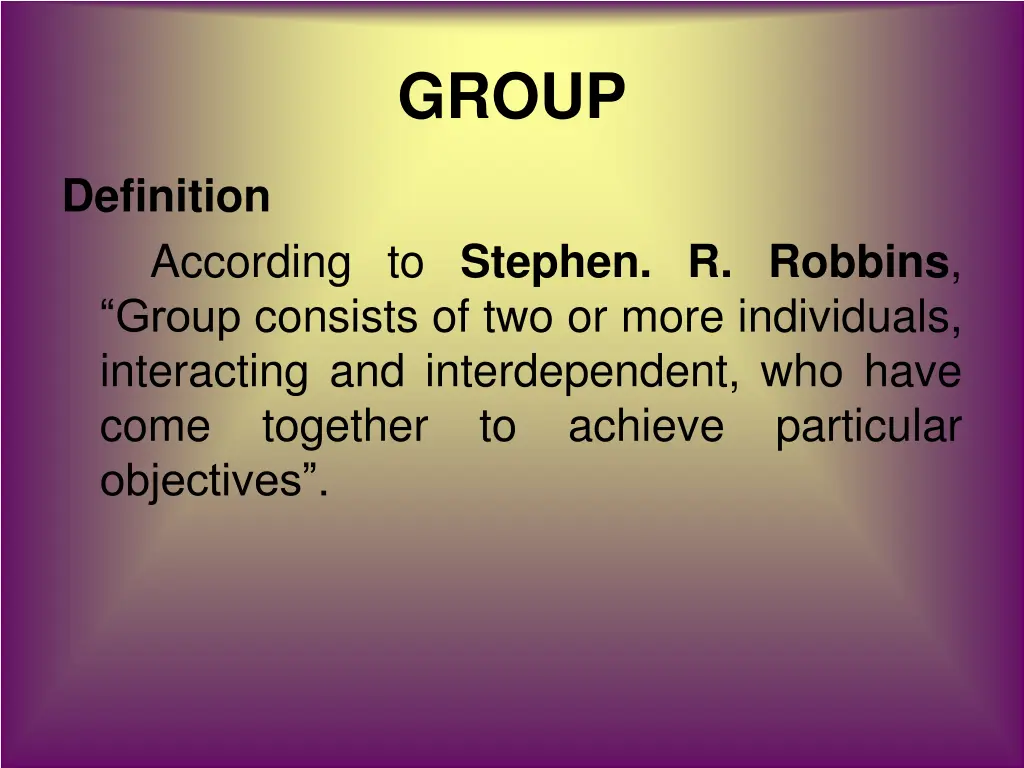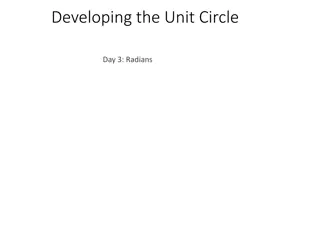
Understanding Group Dynamics and Development
Explore the concept of group dynamics according to Stephen R. Robbins and Kurt Lewin, covering the definition, characteristics, stages of group development, types of groups, formal vs. informal groups, principles, and components. Learn about the interactions, structure, processes, and impact of groups on individuals and organizations.
Uploaded on | 0 Views
Download Presentation

Please find below an Image/Link to download the presentation.
The content on the website is provided AS IS for your information and personal use only. It may not be sold, licensed, or shared on other websites without obtaining consent from the author. If you encounter any issues during the download, it is possible that the publisher has removed the file from their server.
You are allowed to download the files provided on this website for personal or commercial use, subject to the condition that they are used lawfully. All files are the property of their respective owners.
The content on the website is provided AS IS for your information and personal use only. It may not be sold, licensed, or shared on other websites without obtaining consent from the author.
E N D
Presentation Transcript
GROUP Definition According to Stephen. R. Robbins, Group consists of two or more individuals, interacting and interdependent, who have come together to objectives . achieve particular
Characteristics of Group Strong desire of association Cohesiveness Leadership quality Awareness of members Individual properties
STAGES OF GROUP DEVELOPMENT FORMING STORMING NORMING PERFORMING
Types of Group Group Formal Group Informal Group Command group Friendship group Interest group Task group Project group Reference group Committees Membership
Difference between formal and informal group
GROUP DYNAMICS Definition : According to Kurt Lewin, Group dynamics deals with internal nature of groups, how they are formed, what structure and processes they adopt, how they function and affect individual members, other groups and the organization
PRINCIPLES OF GROUP DYNAMICS The members of the group should have a strong belongingness. The more attractive a group is to its members, the greater the influence it would exercise on its members. The greater the prestige of a group member in the eyes of other members, the greater the influence he will exercise.
PRINCIPLES OF GROUP DYNAMICS Successful efforts to change individuals would result in making them conform to the norms of the group. Strong pressure for change in group can be established by creating a shared perception about the need for change. All the members must share the consequences of change. Strain created by changes can be reduced by bringing readjustments.
COMPONENTS DYNAMICS OF GROUP Group norms Group role Group status Group size Group leadership Group composition Group cohesiveness
GROUP COHESIVENESS Meaning: group members are attracted to each other and are motivated to stay in the same group. Cohesiveness is a degree to which
CHARACTERISTICS OF GROUP COHESIVENESS Members share group goals and norms & have common interests and backgrounds. No of members small Members interact communicate effectively Members stand united against all threats Members feel that their need would be satisfied by the group Group should have history of past success frequently and
FACTORS DETERMINING GROUP COHESIVENESS Status of the group Size of the group Inter dependency Time spent together Leadership style External threats Autonomy Communication Management behaviour Location of the group Previous successes Nature of the group
GROUP NORMS Meaning: A group norm is a rule that tells the individual how to behave in a particular group.
CHARACTERISTICS OF GROUP NORMS Norms apply only to behaviour and not to private thoughts and feelings. The norms are the basis for predicting and controlling the behaviour of good members. Norms are identifying the values and ethics of the group members. Not all norms apply to everyone in the group.
FACTORS AFFECTING CONFORMITY TO GROUP NORMS Conformity behaviour to align with the norms of the group. More stable and cohesive. When group goals mesh with individual goals. Differences in two sets of goals. Situational factors like external threats. Personality characteristics of individuals. means adjusting one s
ENFORCEMENT OF GROUP NORMS Reasons for giving importance to enforce norms Group member s behaviour Level of education Group s survival Avoid interpersonal problems
HAWTHORNE EXPERIMENTS Hawthorne Experiment was conducted for more than 5 years at Hawthorne plant of the Western Electric Company. Elton Mayo and the staff of Harvard Business School carried out the experiments. These experiments changed the viewpoints of managers about towards workers.
INITIAL ASSUMPTIONS Each worker is considered as an isolated independent unit. It was possible to measure and influence the actions and performance of each worker. A worker s output depended on the physical environment. Low output was due to ill timings, unnecessary physical motions, lack of proper incentives.
SEQUENCE OF EXPERIMENTS Illumination experiments Relay assembly test room Interview programme Bank wiring group observations
1.Illumination Experiments Impact of illumination on productivity was tested. Two separate groups of employees were chosen. One group was asked to work under steady light, other inconsistent light. group under Two groups did not have major variations in productivity.
2. Relay room experiments Six women employees were chosen. Physical factors like hours of work, rest intervals, temperature, incentives were modified to observe the changes. Researches found that there is no effective relationship between any of the physical factor and productivity.
3. Interview programme 20,000 interviews were carried out by researches. A questionnaire was given to employees and responses were received. Workers explained their problems and what social factor is important according to them. .
4. Bank wiring group observations The objective of bank wiring group observation was to examine how a group influences a worker to restrict his output. Group had 14 workers : 9 wireman 3 solder man 2 inspectors Output of wiremen determined output of solder man and it determined output of inspectors. Group had its own social structure, communication patterns and behaviour but it does not influence performance of an individual worker in any ways..
Findings of Hawthorne experiment Level of production is determined by social norms and not by physiological capacities. Non-economic rewards and sanctions affect the behavior of workers and restrict the effect of economic incentives. Workers act as members of group and not as individuals. Informal leaders play an important role in setting group norms Importance of communication between ranks
Hawthorne experiments - Criticism Unscientific enquiry Restricted scope Lacking in universal applicability Over emphasis on worker satisfaction Undue importance to social norms
ORGANISATIONAL CONFLCIT Meaning: resulting from individuals or groups who differ in attitudes, beliefs, values or needs. Conflict is a natural disagreement
TYPES AND SOURCES OF ORGANISATIONAL CONFLICT Intra personal conflict. Inter personal conflict. Inter group conflict. Inter organization conflict.
1. INTRA PERSONAL CONFLICT 1) Goal conflict Approach-approach conflict 2) Role conflict Person-role conflict Inter-role conflict Approach-avoidance conflict Intra-sender role conflict Avoidance-avoidance conflict Inter-sender conflict
2. INTER PERSONAL CONFLICT Personality differences Perceptions Clash of values and interests Power & status differences Scarcity of resources
3. INTER-GROUP CONFLICT Incompatible goals Task interdependence Resources sharing Joint decision making Organizational ambiguities Introduction of changes
4. INTER ORGANIZATIONAL CONFLICT Conflict among Organizations with similar goals. Conflict among government organizations and agencies. Conflict among corporate office and production units.
METHOD OF HANDLING CONFLICT 1) Preventing conflict 2) Resolving conflict Super ordinate goals Problem solving Reducing interdependence Smoothing Compromise Exchange of personnel Avoidance Appeals to higher authority
SOCIOMETRY Meaning Sociometry is a technique to analyze small groups in order to establish the patterns of interactions among their members. Designed by J.L.Moreno
WHAT IS SOCIOMETRY Sociometry enables us to measure, map and build relationships in order to be explored. It is an essential tool for people to build mature group networks and positive relationship behaviors.
OBJECTIVES OF SOCIOMETRY To explore intra-group relationship To move organization from isolated business units to collaborative groups To strengthen teams To sort out issues of group conflict, trust and identity To understand and address unspoken aspects of everyday group life To develop appropriate behavior for your ideal work culture To integrate thinking, feeling and action in business relationship To release informal leadership abilities
SUPERVISION Definition : According to Viteles, Supervision refers to the direct and immediate guidance and control of the subordinates in the performance of their tasks .
QUALITIES OF A SUPERVISOR Ability to secure cooperation Ability to instruct and inspire Ability to delegate Ability to judge people Ability for orderly thinking Patience Emotional stability Ability to Communicate Knowledge about the organization
FUNCTIONS/REPONSIBILITIS OF A SUPERVISOR COMMUNICATION OF ORDERS, INSTRUCTIONS Essentials of an order When, Whom, Where, How, What, Why INTRODUCTION OF WORK METHOD Introduction of the new machines and method Improvement of existing method Resistance to changes MAKING THE WORK LESS TEDIOUS SELECTION OF EMPLOYEES
INDUCTION OR ORIENTATION OF NEW EMPLOYEES Basic Information briefed to employees Information - received from employees TRAINING EMPLOYEES HANDLING GRIEVANCES ENFORCING DISCIPLINE ENSURING EFFECTIVE COMMUNICATION ENFORCING SAFETY






















